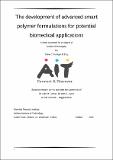| dc.contributor.advisor | Geever, Luke M. | |
| dc.contributor.advisor | Lyons, John G. | |
| dc.contributor.advisor | Higginbotham, Clement L. | |
| dc.contributor.author | Halligan, Shane C. | |
| dc.date.accessioned | 2022-07-04T11:08:20Z | |
| dc.date.available | 2022-07-04T11:08:20Z | |
| dc.date.copyright | 2020 | |
| dc.date.issued | 2020-10 | |
| dc.identifier.citation | Halligan, S.C. (2020). The development of advanced smart polymer formulations for potential biomedical applications. Thesis (Doctor of Philosophy - PdD). Athlone Institute of Technology | en_US |
| dc.identifier.uri | http://research.thea.ie/handle/20.500.12065/4012 | |
| dc.description.abstract | In the past twenty years, a theme in the pharmaceutical industry is to move towards more efficient use of active pharmaceutical ingredients and the need for improved delivery systems. Smart polymers throughout the literature have been suggested for several different biomedical applications such as in-situ forming gels. Fundamentally, this work focuses on the application of temperature responsive polymers as a platforms for improved drug delivery systems. Poly (N-vinylcaprolactam) (PNVCL) is a biocompatible smart polymer that offers superior characteristics for various medical device applications. PNVCL phase transitions can be tailored in order to suit the requirements of current and next-generation devices.. Physically cross-linked Poly (N-vinylcaprolactam)-Vinyl acetate (PNVCL-VAc) copolymers were initially prepared by photopolymerisation. The structure of the polymers was established by Fourier transform infrared spectroscopy, nuclear magnetic resonance and gel permeation chromatography. A determination of the lower critical solution temperature (LCST) of the polymers in aqueous solution was achieved by employing four techniques: cloud point analysis, UV- spectroscopy, differential scanning calorimetry and rheometry. The sol-gel transition was established by the tube inversion method and by rheological analysis. The characteristics of PNVCL with the addition of VAc were determined and the effects on the phase transition were established. The PNVCL based polymers exhibited a decrease in the LCST as the composition of VAc increased. The sol-gel transition was found to be affected by the composition and concentration of the material. Sterilisation of PNVCL was investigated using an industrial scale electron beam sterilisation process. Physically cross-linked Poly (N-vinylcaprolactam)-Vinyl acetate (PNVCL-VAc) copolymers were prepared by photopolymerisation and were subsequently exposed to ionising radiation via electron beam technology. The mechanical characteristics and phase transitions of the physically cross-linked PNVCL samples were tailored by controlling the electron beam irradiation dose. Importantly PNVCL and PNVCL-VAc samples (5 wt% in solution) underwent a phase transition between 33-27 °C, following electron beam irradiation. Furthermore, all samples displayed a Young's Modulus between 1024-1517 MPa depending on the addition of copolymer and electron beam irradiation dose. The electron beam sterilisation process proved successful in enhancing/modifying many fundamental polymer properties, and this ability to formulate and sterilise in one step could prove a very attractive approach for many biomedical applications. Combining a smart polymer system with hot-melt extrusion (HME) could allow for a targeted hybrid drug delivery system. Initial melt processing trials were conducted to determine suitable parameters such as temperature, screw speed, drying time and particle size. PNVCL based smart polymers were successfully extruded; this was achieved through the use of the incorporation of PEG as a plasticiser. PNVCL based samples were subsequently melt processed on a pharmaceutical-grade extruder leading to modified mechanical and phase transition properties. It was observed via FTIR and GPC analysis that the chain length of the polymer increased and that chemical changes were occurring. Therefore, a washing step was developed to remove any unreacted monomers in the smart polymer matrix. This reactive processing approach was found to be extraordinarily efficient and easily adjustable to alter PNVCL properties. Melt processing of PNVCL opens new avenues and potential applications for modifications, such as polymerisation and the blending of different materials within the smart polymer matrix. PNVCL was subsequently used as a smart polymer carrier for Acetaminophen (APAP); Physically cross-linked PNVCL based polymers were prepared by photopolymerisation. Hot-melt extrusion was used as a fabrication technique to incorporate APAP into PNVCL matrix, in an attempt to develop smart drug delivery carriers. FTIR established the structure of the
xxvi
extrudates. Determination of the drug release profile was achieved by employing HPLC. The findings suggest that interactions between PNVCL and APAP varied, according to the drug-polymer ratios. This study is the first of its kind to report the use of temperature-responsive polymers via a melt processing approach. | en_US |
| dc.format | PDF | en_US |
| dc.language.iso | eng | en_US |
| dc.publisher | Athlone Institute of Technology | en_US |
| dc.rights | Attribution-Non-Commercial-Share-Alike-4.0 International | * |
| dc.rights.uri | http://creativecommons.org/licenses/by-nc-sa/4.0/ | * |
| dc.subject | Smart polymers | en_US |
| dc.subject | Biomedical polymers | en_US |
| dc.title | The development of advanced smart polymer formulations for potential biomedical applications. | en_US |
| dc.type | info:eu-repo/semantics/doctoralThesis | en_US |
| dc.contributor.affiliation | Athlone Institute of Technology | en_US |
| dc.identifier.orcid | https://orcid.org/ 0000-0002-6595-7714 | en_US |
| dc.rights.accessrights | info:eu-repo/semantics/openAccess | en_US |
| dc.subject.department | Materials Research Institute AIT | en_US |


